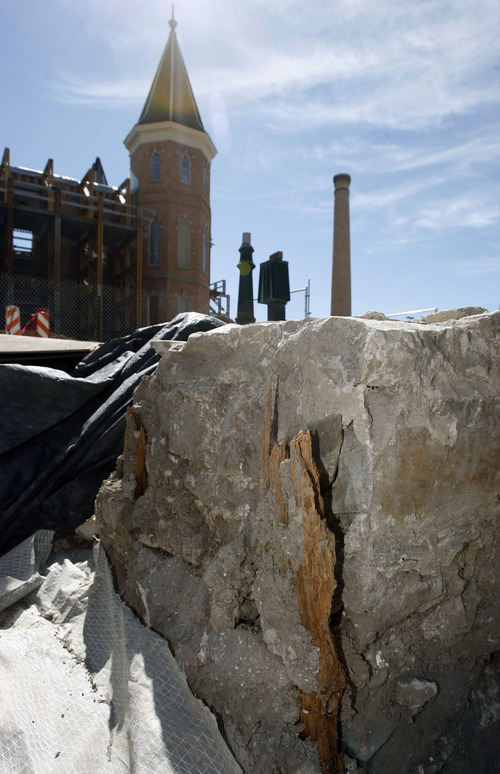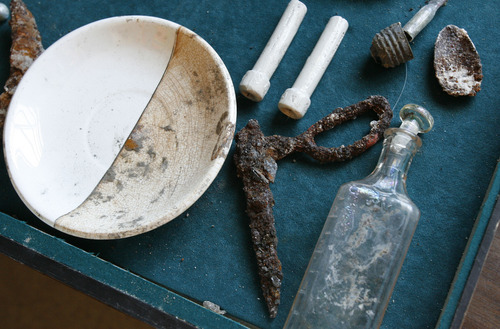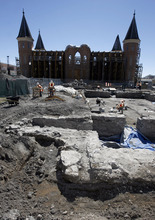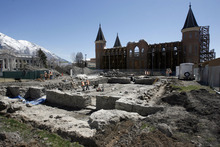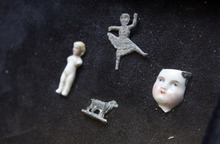This is an archived article that was published on sltrib.com in 2012, and information in the article may be outdated. It is provided only for personal research purposes and may not be reprinted.
Provo • While work has yet to begin to convert the fire-gutted Provo Tabernacle into a Mormon temple, crews have been digging up the building's nearby predecessor.
Brigham Young University students, under the direction of the school's Office of Public Archaeology, have been excavating the remains of the first Provo Tabernacle.
Since February, the students have unearthed the foundation and, after sifting through tons of dirt, artifacts that shed light on life in Provo in the late 19th and early 20th centuries.
The pioneers "put their heart and souls into [building the Tabernacle] even as they were struggling to survive," said Richard Talbot, director of the public archaeology office.
Along with nails, coal from the stoves that heated the building and plaster from the basement walls that still retained some color, the archaeologists found coins, buttons and children's toys, such as a ceramic doll's face the size of a quarter and a toy animal.
"I like to think of the poor [LDS] Primary child who lost his or her favorite toy at church," Talbot said.
The LDS Church gave BYU the opportunity to do an archaeological dig shortly after President Thomas S. Monson announced its intentions to convert the second tabernacle into the Provo City Center Temple.
The dig, Talbot said, gives his students practical experience at archaeology while helping to shed light on how the first tabernacle was constructed.
Workers started building it in 1856, completing the edifice in 1867, when it was dedicated by LDS apostle John Taylor.
That building was designed in the style of a New England meetinghouse, Talbot said. Then-President Brigham Young ordered the design to remind Mormon youths of the land their parents and grandparents left behind when they settled Utah.
The building served as the first meetinghouse in Provo, housing several LDS wards. Members would gather in the basement for Sunday School, women's Relief Society and male priesthood meetings, while worship services took place upstairs in the auditorium.
It later served as a schoolhouse and community gathering place, just as the second Tabernacle did until it was destroyed by fire in December 2010.
While there are plenty of pictures of the old tabernacle, including some showing it standing next to its successor, there are no pictures of the inside.
The dig is yielding clues to how the building was constructed — from its subfloors to the carved stones used to support the pillars that held up the balcony in the auditorium.
Talbot said one of the first surprises during the dig was that the foundation was still there. The building was razed in 1919 — about 36 years after construction began on the second tabernacle — and a historical marker is the only visible sign it was there.
Guided by accounts of where the building stood, the students used ground-penetrating radar to find the foundation's remains, and that information was compared to surveyors' maps from the time period.
Besides unearthing the foundation walls, made from stone quarried from the nearby canyons, the archaeologists also found the remains of a vestry on the south side, as well as original basement steps that were so well preserved they still had chisel marks.
The walls also show the care of pioneer craftsmen, who dressed up the stones on the interior, where they would be seen, while leaving them in their rough state on the exterior.
Talbot said the dig has also uncovered evidence of some other tabernacle uses. Students found slate pencils and slate boards from a school that was housed there, as well as evidence it was used to dry wool for the city's wool industry.
For some of Talbot's students, the dig was the first time they had heard of an earlier tabernacle on the site.
"I heard rumors we were going to be excavating the Tabernacle, and I thought we would be excavating the foundation over there," said Katie Richards, a graduate student in archaeology, pointing to the soon-to-be temple. "It took me a while to figure out that there was a second building here."
Sara Stauffer, another graduate student, said the dig offers a chance for the students to explain to the public what they're doing. She said about five to 50 people come by each day to watch and ask students about the structure.
Work will wrap up in April, Talbot said, and the site will be filled in as part of preparations for the temple groundbreaking. But that doesn't mean the archaeologists' work is done.
Students will return to the lab and start processing the artifacts, putting them into their historical context. The plan is to display them at BYU.
The Provo Municipal Council recently toured the dig, inspiring Councilman Hal Miller to propose that a permanent memorial, possibly allowing people to see the foundation, be part of the church's temple plans.
Mayor John Curtis said he could discuss it with the LDS Church, but was not hopeful more could be done.
"There are a lot of really good things about working with the church," Curtis said, "but they have their opinions."
Twitter: @donaldwmeyers
facebook.com/donaldwmeyers
gplus.to/DWMeyers






